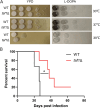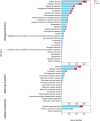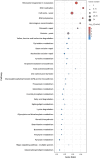The role of uncharacterized protein Taf1 in regulating ATP levels and virulence of Cryptococcus neoformans
- PMID: 40764525
- PMCID: PMC12323153
- DOI: 10.1186/s12866-025-04207-w
The role of uncharacterized protein Taf1 in regulating ATP levels and virulence of Cryptococcus neoformans
Abstract
The human fungal pathogen Cryptococcus neoformans poses significant health risks, particularly to immunocompromised individuals, such as those with HIV/AIDS. In this study, we investigate the role of an uncharacterized protein, Taf1, in regulating ATP levels and virulence in C. neoformans. Our previous proteomic analyses confirmed the expression of Taf1, encoded by the gene CNAG_04232. We found that the deletion of the TAF1 gene resulted in the upregulation of 204 genes and the downregulation of 908 genes. Gene Ontology analysis indicated that these regulated genes are associated with metabolic and cellular processes, as well as ATP-dependent activities. Notably, the TAF1-deficient mutant exhibited impaired growth at elevated temperatures (39°C). Furthermore, in a murine model of infection, mice inoculated with the taf1Δ mutant demonstrated significantly improved survival compared to those infected with the wild-type strain, suggesting a critical role for Taf1 in virulence. Additionally, KEGG pathway analysis of RNA-Seq and metabolomics data revealed significant alterations in fatty acid biosynthesis and degradation pathways following TAF1 deletion. Collectively, these findings underscore the essential role of Taf1 in modulating cellular energy and its implications for the virulence of C. neoformans, thereby paving the way for potential therapeutic strategies targeting this pathogen.
Keywords: Cryptococcus neoformans; ATP; Taf1; Virulence.
© 2025. The Author(s).
Conflict of interest statement
Declarations. Ethics approval and consent to participate: All experimental protocols received approval from Nantong University. Animal procedures were conducted in accordance with the guidelines set forth by the Institutional Animal Care and Use Committee of Nantong University, under ethic number P20250317-007. This study adhered to the ARRIVE guidelines. Consent for publication: Not applicable. Competing interests: The authors declare no competing interests.
Figures






Similar articles
-
Evidence for the role of Irk2 and Irk5 in ATP and metabolism regulation in Cryptococcus neoformans.Front Cell Infect Microbiol. 2025 Jun 18;15:1600041. doi: 10.3389/fcimb.2025.1600041. eCollection 2025. Front Cell Infect Microbiol. 2025. PMID: 40606631 Free PMC article.
-
Lack of an atypical PDR transporter generates an immunogenic Cryptococcus neoformans strain that drives a dysregulated and lethal immune response in murine lungs.mBio. 2025 Jul 9;16(7):e0132125. doi: 10.1128/mbio.01321-25. Epub 2025 May 30. mBio. 2025. PMID: 40444466 Free PMC article.
-
Polyphosphatases have a polyphosphate-independent influence on the virulence of Cryptococcus neoformans.Infect Immun. 2025 Apr 8;93(4):e0007225. doi: 10.1128/iai.00072-25. Epub 2025 Mar 12. Infect Immun. 2025. PMID: 40071953 Free PMC article.
-
Pathogenicity and virulence of Cryptococcus neoformans from an environmental perspective.Virulence. 2025 Dec;16(1):2547090. doi: 10.1080/21505594.2025.2547090. Epub 2025 Aug 14. Virulence. 2025. PMID: 40810603 Free PMC article. Review.
-
Cryptococcal nutrient acquisition and pathogenesis: dining on the host.Microbiol Mol Biol Rev. 2025 Mar 27;89(1):e0001523. doi: 10.1128/mmbr.00015-23. Epub 2025 Feb 10. Microbiol Mol Biol Rev. 2025. PMID: 39927764 Review.
References
-
- Park BJ, Wannemuehler KA, Marston BJ, Govender N, Pappas PG, Chiller TM. Estimation of the current global burden of Cryptococcal meningitis among persons living with HIV/AIDS. AIDS. 2009;23(4):525–30. - PubMed
MeSH terms
Substances
Grants and funding
- BK20240948/Natural Science Foundation of Jiangsu Province
- BK20240948/Natural Science Foundation of Jiangsu Province
- JC2023043/Nantong Jiangsu Scientific Research Project
- JC2023043/Nantong Jiangsu Scientific Research Project
- 24KJD430010/Natural Science Research of Jiangsu Higher Education Institutions
- 23KJB550004/Natural Science Research of Jiangsu Higher Education Institutions
- 24KJD430010/Natural Science Research of Jiangsu Higher Education Institutions
- Guike AB24010134/Guangxi Science and Technology Major Program
- Guike AB24010134/Guangxi Science and Technology Major Program
- JSSCBS20230419/High-level Innovation and Entrepreneurship Talents Introduction Program of Jiangsu Province of China
- 32300047/National Natural Science Foundation of China
LinkOut - more resources
Full Text Sources

